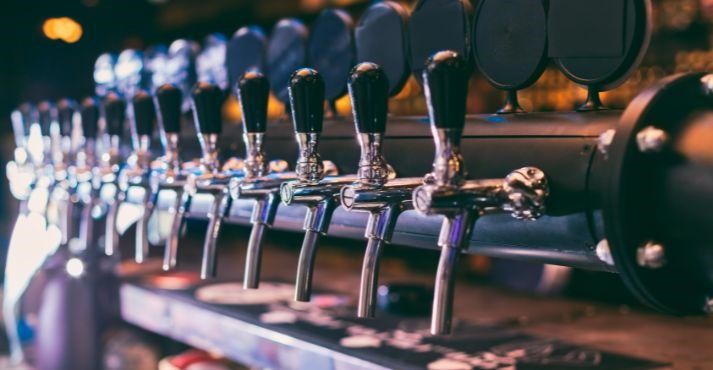In Singapore, beer isn’t just a drink—it’s a part of life. People here love their beer, and the numbers prove it! Every year, Singaporeans drink a lot of it, showing how much they enjoy their brews. With about 6% anticipated growth between 2024 and 2028, it’s a buzzing sector.
But among all the different types of beer, there’s something special about draft beer. It’s not just about the taste—it’s about the experience. Picture this: a perfectly poured glass of cold, refreshing beer straight from the tap. That’s what draft beer is all about.
But what is draft beer, and what makes it so unique? Let’s take a closer look. We’ll explore how it’s made, why it tastes so good, and why it’s a favorite among beer lovers everywhere. So, grab a seat, pour yourself a cold one, and let’s explore the world of draft beer together!
What is Draft Beer?
Draft beer, sometimes spelled draught beer, is served straight from a keg or cask without pasteurization or filtration. Unlike bottled or canned beer, which undergo additional processing, draft beer retains its freshness and unique flavor profile.
Imagine a crisp, cold pint poured directly from the tap— that’s draft beer! Because it skips the extra steps of pasteurization and filtration, it maintains more of its natural flavors, giving it a distinct taste that beer enthusiasts love.
It’s like having the brewery experience right at your fingertips! Plus, since it’s served fresh from the keg, draft beer often has a smoother texture and a frothy head that adds to its appeal.
So, whether you’re at a bar, a restaurant, or a backyard barbecue, draft beer is the go-to choice for those who appreciate the pure, unadulterated taste of a perfectly crafted brew.
How is Draft Beer Served and Stored?

Draft or draught beer is served and stored carefully to ensure freshness and quality. When it comes to serving, the process begins with tapping the keg, which involves attaching a tap to the keg’s valve. This allows the beer to flow freely from the keg to the tap system.
Regulating the CO2 pressure is crucial in maintaining the proper beer carbonation level and preventing it from becoming flat. The beer is dispensed into a glass through a tap system, ensuring a smooth and frothy pour that adds to the drinking experience.
In terms of storage, maintaining proper conditions is essential. Temperature control is vital in preserving the beer’s flavor and preventing it from spoiling. Kegs should be stored in relaxed environments to avoid exposure to heat, which can cause the beer to become stale.
Additionally, keg rotation is essential to ensure that older kegs are used first, preventing any beer from sitting too long and losing its freshness.
Bar industry trends are also driving innovations in the way beer is served, with many bars investing in state-of-the-art equipment to offer the best experience for their customers. These trends are helping bars stay competitive and enhance the overall beer experience for patrons.
These practices align with current beer industry trends, where a focus on quality and freshness is vital. Breweries and bars alike are investing in equipment and training to ensure that draft beer is served and stored correctly, meeting the high standards of today’s discerning beer enthusiasts.
Types of Draft Beer Systems
Nothing compares to draft beer when it comes to enjoying the freshest and most flavorful beer. To fully appreciate the vast array of draught beer flavors available, it’s essential to understand the different types of draft beer systems used to serve them.
From traditional hand-pumped casks to modern kegerator setups, the variety of draft beer systems ensures something for every beer enthusiast. Let’s explore the various types of draught or draft beer systems and how they contribute to the enjoyment of this beloved beverage.
1. Direct Draw Beer System

A Direct Draw Beer System is standard in many bars and restaurants, offering a straightforward setup for dispensing draft beer. This system stores kegs directly beneath the tap, usually within a refrigerated cabinet.
This setup minimizes the distance beer travels from keg to tap, ensuring freshness and minimizing waste. Maintenance is relatively simple, as cleaning and line maintenance can be easily performed.
However, one limitation of this system is its space requirement, as each tap requires dedicated refrigerated space.
Additionally, direct draw systems may be more susceptible to temperature fluctuations, potentially affecting beer quality.
2. Long Draw Beer System

The Long Draw Beer System is ideal for establishments with limited space behind the bar or those serving beer over longer distances. In this setup, kegs are stored in a remote location, often in a walk-in cooler, and beer lines run from the kegs to the bar’s taps.
This system allows for greater flexibility in tap placement and minimizes clutter behind the bar. Additionally, because beer lines are insulated and cooled, they help maintain consistent temperatures, preserving beer quality.
However, long-draw systems require more complex installation and maintenance, which can result in higher upfront costs and ongoing food and beverage costs.
3. Air-Cooled System
An Air-Cooled System offers a cost-effective solution for serving draft or draught beer in locations where installing a refrigeration unit is impractical or cost-prohibitive. With this system, kegs are stored at room temperature, and air is blown over the beer lines to cool the beer as it is dispensed.
Air-cooled systems are relatively easy to install and maintain, making them popular for outdoor events or temporary setups.
However, they may be less effective at maintaining consistent temperatures compared to refrigerated systems, which can impact beer quality, particularly in warm climates.
Benefits of Draft Beer
Now that we understand draft beer let’s look at its many advantages, which make it a preferred choice for beer fans, particularly given the current health trends in the beverage sector.
1. Freshness:
At the heart of draft beer’s appeal lies its unmatched freshness. Unlike bottled or canned beer, which may spend prolonged periods on shelves before consumption, draft beer is served directly from the keg to the glass.
This direct dispensing method ensures that the beer maintains its optimal flavor profile, devoid of staleness or taste alteration.
2. Variety:
Draft beer enthusiasts relish the vast array of beer styles and flavors at their fingertips. The true meaning of draft beer stresses this diversity, highlighting the multitude of options that draft beer presents to consumers. The possibilities are endless, from crisp lagers to robust stouts and hoppy IPAs.
Bars, pubs, and breweries frequently rotate their draft selections, allowing patrons to explore and sample different brews each visit. This variety caters to diverse palates and encourages a sense of excitement and discovery among beer enthusiasts.
3. Environmentally Friendly:
Draft beer is an eco-friendly choice for those concerned about the environment. Unlike bottled or canned beer, which requires individual packaging, draft beer is served from reusable kegs.
This reduces waste, like bottles and cans, which helps lessen our environmental impact. Additionally, kegs can be recycled and reused, reducing beer consumption’s environmental footprint. Consumers can play their part in conserving the planet by choosing draft beer.
4. Healthier Option:
For health-conscious individuals, draught or draft beer offers a more straightforward and healthier alternative to sugary or artificially flavored drinks. With fewer additives and preservatives, draft beer is considered more wholesome.
It’s brewed with natural ingredients and crafted with care, resonating with consumers seeking genuine drinking experiences. This authenticity adds to the appeal of draft beer for those mindful of their dietary choices.
5. Consistency:
Consistency is vital to enjoying a good beer. Draft beer excels in this aspect, offering a consistent taste and quality with each pour.
The controlled dispensing process, regulated CO2 pressure, and maintained serving temperatures ensure that every glass of draft beer is fresh and flavorful.
This reliability improves the drinking experience for consumers, making draft beer a popular choice among beer enthusiasts, especially those favoring craft beers over commercial options.
Draught Beer vs. Bottled Beer

When choosing between draught or (draft) beer and bottled or canned beer, distinct differences influence taste, aroma, freshness, and overall drinking experience.
| Aspect | Draught Beer | Bottled/Canned Beer |
|---|---|---|
| Taste | Often perceived as a fresher with a smoother taste. | It may have a slightly different taste due to the packaging. |
| Aroma | Offers a rich aroma with nuances of hops and malt. | The aroma may vary, often influenced by packaging materials. |
| Freshness | It's generally considered fresher, as it's served directly from kegs. | It may vary depending on storage conditions and age. |
| Drinking Experience | It provides a unique experience, with the opportunity to enjoy beer straight from the tap. | Offers convenience and portability, suitable for various settings. |
Draught Beer: Draught beer is renowned for its fresh taste and smooth texture. It’s served directly from kegs, preserving its freshness and flavor. Draught beer often boasts a rich aroma with distinct flavors that are appealing to enthusiasts.
Additionally, draft beer sizes are varied, from pints to pitchers, catering to different preferences and occasions.
Bottled or Canned Beer: Bottled or canned beer offers convenience and portability, making it suitable for various settings.
While the taste may differ slightly from draught beer due to packaging, bottled or canned beer still provides a refreshing drinking experience. It comes in standard sizes, such as bottles and cans, making it easy to enjoy at home or on the go.
What is Draft or Draught Beer (FAQs)
What Is Special About Draft Beer?
Draft beer stands out for its unparalleled freshness and unique serving method. Unlike bottled or canned beer, which may lose some freshness over time, draft beer is served directly from the keg, ensuring optimal taste and aroma.
Its smooth texture and frothy head enhance the drinking experience, making draft beer a favorite choice for many enthusiasts.
What Is the Difference Between Draft Beer and Craft Beer?
While draft beer refers to serving beer directly from a keg, craft beer is a term that describes beer produced by small, independent breweries. While some craft beers are available on draft, others may be bottled or canned.
Is Draft Beer Stronger?
Draft beer’s strength varies depending on the specific beer being served. It is less robust than other types of beer. The brewing process and recipe used by the brewery determine the alcohol content.
Conclusion
The world of beer offers a diverse array of options, each with its unique characteristics and advantages. Throughout this exploration of what draft beer, also known as draught beer, is, its freshness, variety, and environmental friendliness have stood out as key attributes.
From its rich flavors and smooth texture to its minimal packaging waste and sustainable practices, draft beer represents the principle of a premium drinking experience.
While bottled or canned beer provides convenience and portability, draft beer delivers supreme freshness straight from the tap.
Whether enjoying a pint at a local pub or savoring a cold one at home, draft beer continues to attract beer enthusiasts with its authenticity and quality.
So, the next time you’re craving a refreshing beverage, consider the unmatched appeal of draft beer and indulge in its flavorful offerings.





























